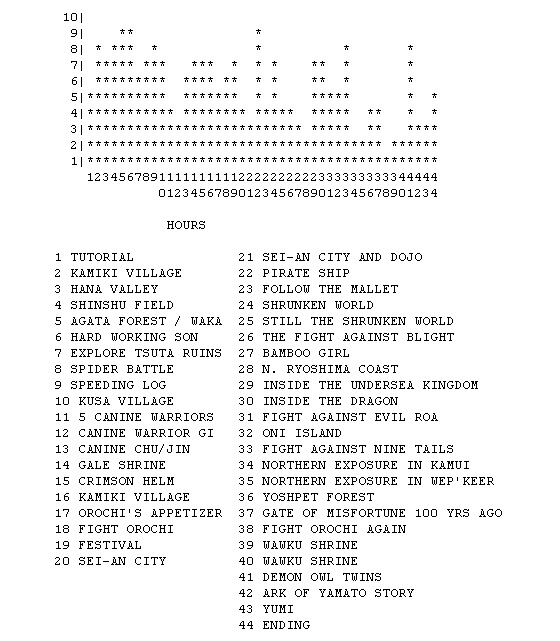Okami Side Commentaries
February 16th, 2010

Finally, I’ve said all that I need to say about Okami, and then some. The final scrappy remarks can be found below:
Nonlinear Narrative
The nonlinear storytelling framework famously used in Prince of Persia: The Sands of Time, is also used in Okami, albeit, a little bit differently. The basic idea is that the main story is a narration, and at some point the narration ends and another dimension is added to the story through the ensuing events. In Okami, after the credits roll, Issun, the travelling artist, is revealed to be the narrator. Because Issun narrates Okami‘s story as well as painting it to scroll, his position after the events of the main storyline are subtly revealed: he takes the place of his father, passing down the story of Amaterasu and teaching the younger sprites of their purpose.
Hour-by-Hour Ratings
After I finished Okami, I looked up a guide to see what secrets were lying under the hood. This play guide by zukowskc at GameFAQs, featured a neat little chart which I though would be worth discussing:

This chart rates each individual hour of Okami‘s play length out of ten, effectively mapping out the interest levels of the player over the time of play. I agree with most of the rankings, but more importantly, I love the way zukowskc’s chart outlines the stamina phenomena I described in my prior post.
Backtracking
It’s worth noting that throughout Okami there is a decent amount of backtracking. Fortunately, obstacles requiring brush techniques acquired later in the game are scattered throughout the earlier hub areas, ensuring that backtracking isn’t a time hole, but instead an opportunity to re-approach old areas with new abilities. I discussed this previously in regards to Metroid Prime 3 as well.
Viewtiful Visuals
Stylistically people claim that Okami is unique, I disagree somewhat. In the same way Super Mario Galaxy is an evolution of Donkey Kong: Jungle Beat (and before that Pikmin 2), Okami is an evolution of artistic techniques established in Viewtiful Joe. Many of the same tricks, such as the pre-rendering and cel-shading, are shared amongst both games.
Get me that OST
It only took me a few hours into Okami to decide that I adamantly wanted to buy the original soundtrack. I don’t make a habit of buying video game OSTs, except for my personal favourites and it’s right there where Okami belongs. The music is a mix of Zelda and Final Fantasy Tactics with a nature themeatic.
Back of the Manual
There’s a really genuine explanation of Okami‘s cultural origins at the back of the instruction manual which is a really clever, necessary addition on Capcom’s part.



 Game Design Companion: A Critical Analysis of Wario Land 4 - $7.99
Game Design Companion: A Critical Analysis of Wario Land 4 - $7.99 Level Design: Processes and Experiences
Level Design: Processes and Experiences Speed Boost: The Hidden Secrets Behind Arcade Racing Design - $5.99
Speed Boost: The Hidden Secrets Behind Arcade Racing Design - $5.99 Adventures in Games Analysis: Volume I - $5.99
Adventures in Games Analysis: Volume I - $5.99







